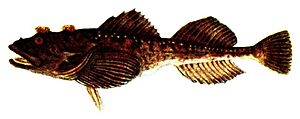Fourhorn sculpin facts for kids
The fourhorn sculpin (Myoxocephalus quadricornis) is a cool type of ray-finned fish that belongs to the family called Cottidae, also known as typical sculpins. This fish lives all over the Holarctic region, which includes the northern parts of the world. You can find it in salty ocean water, brackish water (a mix of fresh and salt water), and even in fresh water.
Quick facts for kids Fourhorn sculpin |
|
|---|---|
 |
|
| Conservation status | |
| Scientific classification | |
| Synonyms | |
|
Contents
How Scientists Name Fish
The fourhorn sculpin was first officially described by a famous scientist named Carl Linnaeus in 1758. He gave it the name Cottus quadricornus. Scientists sometimes change how animals are classified as they learn more. For example, in 2020, some scientists studied the DNA of the fourhorn sculpin. They found it was more closely related to another fish called the belligerent sculpin. Because of this, they suggested that the fourhorn sculpin should be moved to a different scientific group.
There's also a fish called the deepwater sculpin. It lives in freshwater lakes in North America, like the Great Lakes. This fish is very similar to the fourhorn sculpin. Some scientists even think it might be a type of fourhorn sculpin.
What Does the Fourhorn Sculpin Look Like?
The fourhorn sculpin has a big, bumpy head with lips that stick out. It also has four bony bumps on its head. However, the four bumps are not present on the fish that live in freshwater lakes.
Its pectoral fins (the ones on its sides) are large and round. The freshwater forms of this fish look a bit like the Alpine bullhead and European bullhead. But you can tell them apart because the fourhorn sculpin's back fin and bottom fin end further forward. This makes its tail section longer.
The fish's head, body, and fins are brownish. They have mottled patterns and dark stripes. Male fourhorn sculpins have a yellowish-brown belly, while females have a whitish belly. In the sea, these fish can grow to be about 20 to 30 centimeters (8 to 12 inches) long. In lakes, they are usually smaller, rarely growing more than 15 centimeters (6 inches).
Where Does the Fourhorn Sculpin Live?
The fourhorn sculpin is a demersal fish, which means it lives near the bottom of the water. It mainly lives in the cold, brackish coastal waters of the arctic region. You can find it in places like Canada, Greenland, Russia, and Alaska. It also lives in the boreal Baltic Sea, which is a colder sea in northern Europe.
Besides these salty and brackish areas, there are also populations of fourhorn sculpins that live only in freshwater lakes. These lakes are found in countries like Norway, Sweden, Finland, and Karelia. You can also find them in Arctic Canada, in areas like Nunavut and the Northwest Territories.
Life Cycle and Habits
The fourhorn sculpin eats small animals that live on the bottom of the water. It also likes to eat fish eggs.
These fish breed in the winter, usually between November and March. When it's time to lay eggs, the male sculpin digs a hollow spot in the sand or mud at the bottom. The female then lays her eggs in this spot. After the eggs are laid, the male stays to guard them. He fans the eggs with his fins to keep them clean and get enough oxygen. This caring process lasts for about 100 days until the eggs hatch.


